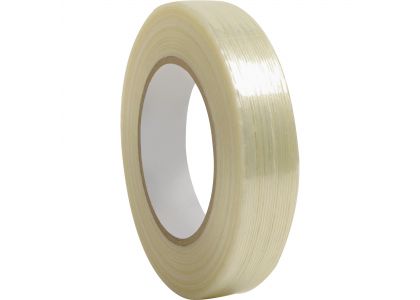
In demanding industrial packaging environments, bi-directional fiberglass reinforced filament tape, filament tape tensile strength, filament tape applications, polyester filament tape, pressure sensitive filament tape, and filament reinforced tapes form the core toolkit for modern packaging engineers. These advanced materials integrate high-strength glass fiber reinforcement with precision-engineered adhesive systems to deliver exceptional load-bearing capacity, tear resistance, and durability. Understanding the technical underpinnings of these products is crucial for optimizing performance in scenarios ranging from heavy machinery pallet stabilization to delicate electronics bundling. This article delves into the substrate and reinforcement architecture, manufacturing nuances, performance metrics, real-world use cases, automation integration, and emerging trends shaping the future of filament tape technology.
Modern polyester filament tape and polypropylene-backed variants begin with a biaxially oriented film. During extrusion, molten polymer is cast into a uniform sheet, then stretched longitudinally and transversely to enhance tensile properties and dimensional stability. This oriented backing resists deformation under load and provides a smooth surface for adhesive coating.
Embedded within the backing are continuous glass filaments—either unidirectional or woven into a cross-grid for true bi-directional fiberglass reinforcement. The filaments, typically 5–10 μm in diameter, are spaced at precise intervals (often 2–3 mm apart) to distribute stress evenly. The resulting composite—known generically as filament reinforced tapes—combines the film’s flexibility with the filaments’ high modulus, achieving tensile strengths well above 200 N/cm in both machine and cross directions.
Producing consistent, high-performance filament tape involves a multi-stage sequence:
Film Extrusion & Orientation
Polypropylene or polyester resin is melted and cast into a thin film.
A biaxial tenter frame stretches the film to impart uniform molecular orientation, boosting tear resistance.
Adhesive Coating
Acrylic or rubber-based adhesives are applied via a gravure or knife-over-roll coater.
Coating weights range from 15 to 35 g/m², balancing initial tack and long-term shear retention.
Filament Embedding
Continuous glass yarns are laid onto the wet adhesive under controlled tension.
Precise filament spacing and alignment are critical: too close risks stiffness, too far reduces reinforcement.
Topcoat Lamination (Optional)
A thin polymer overlayer encapsulates filaments, protecting them from abrasion and moisture.
Common materials include low-density polyethylene or UV-resistant polymers for outdoor applications.
Slitting & Rewinding
Master rolls (often 1.5 m wide) are slit into standard widths—from 12 mm for cable harnessing to 96 mm for pallet stabilization.
Finished rolls are wound to specified lengths (typically 25–100 m) and core diameters.
Throughout production, in-line sensors monitor film thickness, adhesive weight, filament tension, and roll winding parameters, ensuring each batch meets strict tolerances.
To evaluate suitability for specific filament tape applications, manufacturers test key attributes:
Tensile Strength (ASTM D3759)
Measures peak load before break; bi-directional tapes often exceed 220 N/cm longitudinally and 180 N/cm transversely.
Tear Propagation Resistance (ASTM D1004)
Assesses force required to initiate and propagate a tear; embedded filaments arrest cracks, enhancing durability.
Adhesive Shear & Peel (ASTM D3654 / D3330)
Quantifies bond strength over time and peel resistance from various substrates (e.g., cardboard, metal, plastic).
Environmental Aging
Exposes samples to cycles of high/low temperature, UV, and humidity to verify performance retention in harsh climates.
These metrics guide engineers in selecting the optimal tape for load-bearing, sealing, or bundling tasks.
Heavy Machinery Components
A major equipment OEM replaced steel banding with filament reinforced tapes, reducing packaging weight by 40% and cutting material costs by 15%.
Electronics Pallet Securing
A consumer electronics firm uses polyester filament tape to stabilize sensitive devices on pallets, virtually eliminating vibration-induced damage in transit.
Pipe and Cable Bundling
Outdoor utility contractors rely on pressure sensitive filament tape with rubber-based adhesives to bundle conduit and cables; the tape maintains adhesion in wet, dusty conditions.
E-commerce Fulfillment
High-speed packing lines integrate automated dispensers to apply filament tape around cartons; throughput increases by 25% compared to standard carton tape.
Automotive Assembly Lines
Sub-assemblies are secured with narrow (12 mm) bi-directional filament tape, enabling precise bundling of wire harnesses and hoses without slippage.
Maximizing the benefits of filament tapes requires compatible hardware:
Manual & Semi-Automatic Dispensers
Ergonomic handheld tools maintain consistent tension and reduce operator fatigue.
Fully Automated Systems
Inline applicators integrate with conveyors and robots, applying tape at programmed angles and tension levels.
Tension Control Modules
Ensure uniform filament alignment and prevent web breaks during high-speed application.
Inline Inspection & Quality Assurance
Vision systems detect missing filaments, adhesive voids, or roll defects, automatically rejecting substandard rolls before packaging.
Looking ahead, the filament tape industry is exploring:
Nanofiber Composite Reinforcement
Incorporating nanocellulose or carbon nanotubes to boost specific strength and reduce weight.
Smart Adhesive Systems
Temperature- and pressure-responsive adhesives that adapt tack levels in real time.
Recyclable & Bio-Based Backings
Development of separation techniques to reclaim glass filaments and polymer backings for closed-loop recycling.
IoT-Enabled Roll Tracking
Embedding RFID or QR codes in cores for real-time inventory and usage monitoring.
SUMMARY
Through precise control of backing orientation, adhesive formulation, and filament integration, bi-directional fiberglass reinforced filament tape delivers unmatched performance in tensile strength, tear resistance, and environmental durability. By aligning product specifications with application demands—and leveraging automation for consistent application—engineers can achieve significant gains in packaging efficiency, cost savings, and supply-chain reliability.